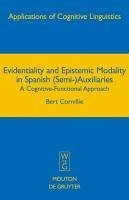This book is the first in-depth study of the conceptual and formal differences between evidential and epistemic auxiliaries in Spanish. The proposed account explores the parallelism between form and meaning and is based on frequency tests in spoken, written, synchronic and diachronic corpora. By doing so, the book not only constitutes a considerable innovation with respect to the previous Spanish accounts in terms of (subject) raising, but also adds a new dimension to Cognitive Grammar notions such as transparency, focal prominence, profile, dynamic reference point and subjectification.
Dieser Download kann aus rechtlichen Gründen nur mit Rechnungsadresse in A, B, BG, CY, CZ, D, DK, EW, E, FIN, F, GR, HR, H, IRL, I, LT, L, LR, M, NL, PL, P, R, S, SLO, SK ausgeliefert werden.
"Bert Cornillie's book represents a valuable and interesting contribution to the studies of the evidentiality and epistemic modality by providing a thorough case study of their form and function in Spanish."Barbara Shaffer in: Review in Cognitive Linguistic 8:1/2010
"Bert Cornillie's book represents a valuable and interesting contribution to the studies of the evidentiality and epistemic modality by providing a thorough case study of their form and function in Spanish."
Barbara Shaffer in: Review in Cognitive Linguistic 8:1/2010
"Bert Cornillie's book represents a valuable and interesting contribution to the studies of the evidentiality and epistemic modality by providing a thorough case study of their form and function in Spanish."
Barbara Shaffer in: Review in Cognitive Linguistic 8:1/2010

